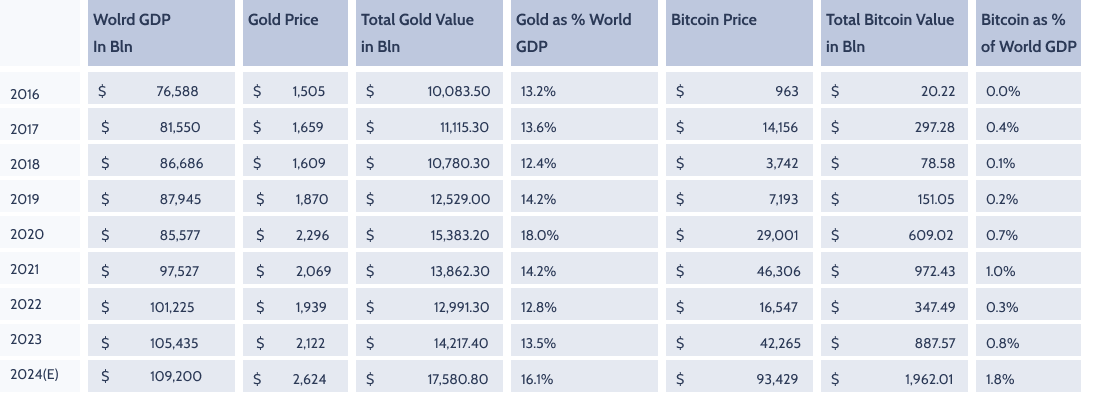Bitcoin Price Prediction 2025


Can Bitcoin Sustain Its Momentum? Opportunities and Challenges Ahead
Bitcoin price prediction for 2025 has been a topic of great interest, as Bitcoin has been one of the best-performing assets over the last decade. For the previous eight years, its price has increased nearly 100 times, going from 963 USD at the end of 2016 to 93,429 USD at the end of 2024. Is this kind of growth sustainable? Could the fairy tale continue
Analyzing the Data: Bitcoin, Gold, and Global GDP
Let’s look at the numbers, but before we do, let’s explain where we get the data. First, we will look at the Total World GDP since 2016. The data comes from macrotrends.com. Second is the data on gold. It comes from the World Gold Council. According to them, in 2019, around 6.7 billion ounces (190 metric tons) of gold existed. According to them, gold mining increases the total supply by around 1% annually. We are going to use that quantity for all our gold data. Technically speaking, the total gold available in 2024 would be higher than 6.7 billion ounces, but not by much.
Finally, we will treat Bitcoin as if all 21 million Bitcoins that could be mined were mined and available for sale in all previous years.
A few words about how the numbers in each row were derived: in 2016, the world nominal GDP was 76 588 billion USD. The price of gold was 1505 USD/oz, and there were 6.7 billion ounces of gold. That would make the total gold value 10 083 billion USD or 13,2% of the World GDP. The bitcoin price was 963, and the total bitcoin capitalization would have been 20 billion USD, 0% of the world’s GDP.
Bitcoin Price Prediction 2025: Market Position and Trends
Now, let’s look at the last row – 2024.
- World GDP: 109,200 billion USD
- Gold Market Capitalization: 17,580 billion USD, or 16.1% of GDP
- Bitcoin Market Capitalization: 1,962 billion USD, or 1.8% of GDP
For context, the total market capitalization of the S&P 500 is around 52 trillion USD (as of December 2024). The market caps of Apple (AAPL), Microsoft (MSFT), and Nvidia (NVDA) each exceed 3 trillion USD.
Despite the media hype around Bitcoin, its market cap remains significantly smaller than some of the world’s largest companies. What happens to MSFT is arguably as important, if not more so, than Bitcoin in terms of financial influence.
As we analyze the data, certain patterns begin to emerge. Let’s take a closer look at them one by one.
Pattern 1: No $1 Million Bitcoin Anytime Soon
Most likely, we are not going to see 1 MM price per Bitcoin any time soon (not in the next 10 years).
The Bitcoin market cap is no longer negligible. Should the price of Bitcoin increase to 1 MM USD (10 times increase), that would imply that Bitcoin’s market cap will be bigger than that of Gold and nearly 18% of the World’s GDP.
While this is theoretically possible, practically, we think this is almost impossible. Gold has been and continues to be a store of value and the only choice of reserves for the big central banks. While Bitcoin has gained adoption, that adoption has only been marginal when it comes to Central Banks, and it is unrealistic to expect that major central banks will switch their reserves from gold to digital assets soon.
Pattern 2: Optimistic Price Target – $500K per Bitcoin
Optimistic Price Target for Bitcoin is 500k/Bitcoin over the next several years
At 500k USD per Bitcoin, the market capitalization will be 10 Trln USD or 9% of the World’s GDP. It is hard to believe that even if adoption rates increase, Bitcoin as an asset could attract more money than gold (13%-18% of World GDP historically). Gold has served as a store of value for thousands of years. Its ability to function in emergency or disaster situations without requiring electricity or internet access makes it highly desirable—an advantage that Bitcoin simply cannot provide.
Pattern 3: Lower Volatility Going Forward
Lower volatility going forward. Given its large capitalization, Bitcoin’s upside volatility will be much more subdued. Yes, trillion-dollar capitalization stocks trade much differently from small-cap stocks. In general, we expect volatility to contract, but that contraction should be much more pronounced on the upside.
Pattern 4: ETFs and Retail Flow Will Support Bitcoin
ETFs and Listed Options on Bitcoin will bring retail flow to the asset class. Given that there are ETFs on Bitcoin and options on those ETFs, we expect to see many retail products that use the ETFs or their options (especially in Asia). Yes, ETFs will make investing easy for many retailers. Given the asset class’s historically great performance, we expect retailers to continue to invest in the space for the next several years at least, supporting a bullish case for prices.
Conclusion: Bitcoin’s Future Outlook
In conclusion, we are going to say that Bitcoin reminds us of a fast-growing teenager. Growth has been nothing short of amazing, but past performance should be impossible to maintain for too long at the current valuation. Given the historical track record, above-average growth should not be surprising, but prices over 500k USD per Bitcoin seem like the best-case, high-end price target for the next several years. Those interested in the space may find CoinShares Physical Bitcoin ETF (BITC) to be a strong option. The ETF offers high liquidity and competitive fees and is listed on EURONEXT.
Get the trading edge you need in today’s markets – sign up for our monthly newsletter featuring in-depth expert analysis, hot market insights, and exclusive trading strategies.

